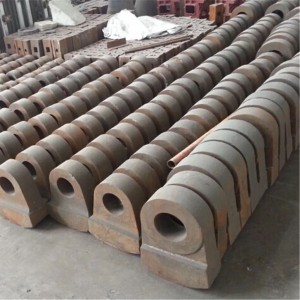During the continuous operation of the crusher, the hammer heads are subjected to tremendous impact and wear. How can a common metal material be made to have sufficient hardness to resist wear and tear as well as good toughness to withstand impact? This relies on precise heat treatment processes to achieve a perfect balance between hardness and toughness.
The core value of heat treatment: giving materials a second life
Heat treatment is a method of altering the internal structure of metals by precisely controlling the heating and cooling processes. For the hammer heads of crushers, this process is not merely a simple “heat up and then cool down”, but an art that requires precise control. Proper heat treatment can make the same material exhibit completely different performance characteristics, just like a craftsman turns an iron block into a sharp knife through meticulous forging.
Quenching process: Creating a hard shell
Quenching is the most crucial step in the heat treatment process. After heating the hammer head to a specific temperature and maintaining it for a sufficient period of time, quickly place it in the cooling medium for rapid cooling. During this process, the internal structure of the metal undergoes a transformation, forming an extremely hard structure. Just as an experienced blacksmith knows when to immerse a red-hot iron block in water, modern heat treatment processes require precise control of each parameter: the heating temperature should neither be too high nor too low, the holding time should be just right, and the cooling rate must be strictly controlled.
The selection of the cooling medium is also very important. Different media have different cooling characteristics, which will affect the final hardness and internal stress distribution. Some media have a faster cooling rate and can achieve higher hardness. Some cool down more slowly, which can reduce the risk of cracking. This requires careful selection based on the material composition and the expected performance.
Tempering process: Releases stress and enhances toughness
Although the hammer head has a high hardness after quenching, there is considerable internal stress and it is relatively brittle in texture. At this point, tempering process is needed to adjust the performance. Tempering is the process of reheating a quenched hammer head to a lower temperature, holding it for a period of time, and then cooling it.
During this process, the internal structure of the metal undergoes further transformation, stress is released, and toughness is significantly enhanced. Just as a sculptor meticulously polishes every detail of his work, the tempering process requires precise control of temperature and time. Excessively high temperatures may reduce hardness by too much, while excessively low temperatures result in insufficient stress release. Only by finding the most suitable balance point can the ideal effect of being both hard and tough be achieved.
Process coordination: Achieve the best balance of performance
No single heat treatment process can achieve the desired effect. Only by organically combining them can hammer heads with excellent performance be manufactured. The common process route is to first quench and then temper. This is like first putting on a hard armor for the hammerhead and then tempering it to make this armor more flexible and durable.
The accuracy of temperature control is of vital importance throughout the entire heat treatment process. Modern heat treatment equipment can precisely control the heating rate and holding temperature, ensuring that each hammer head can achieve a uniform and consistent treatment effect. The cooling process is equally important, and it is necessary to ensure that each part can cool evenly at an ideal speed.
Quality Assurance: Continuous monitoring and improvement
To ensure the stability of heat treatment quality, it is necessary to establish a complete process monitoring system. From the raw materials entering the factory to the final finished products, every link must undergo strict inspection. Performance tests are conducted through regular sampling to ensure that the product always meets the usage requirements.
At the same time, it is also very important to continuously optimize the process parameters based on the feedback from actual usage. Hammerheads under different working conditions may have different performance requirements. By adjusting the heat treatment process, certain aspects of performance can be improved in a targeted manner, enabling the product to better meet the needs of users.
Conclusion
Heat treatment processes may seem simple, but they actually involve profound materials science principles and rich practical experience. It is like an unknown artist who, by precisely controlling temperature and time, transforms ordinary metal materials into durable working components. Each quenching and tempering process is a meticulous refinement of the material’s properties, aiming to ensure that the hammerhead of the crusher performs more outstandingly and has a longer service life during operation.
Post time: Aug-21-2025


